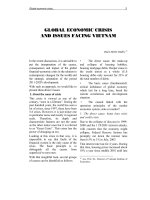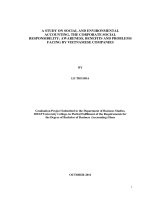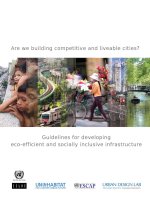Global Eco. crisis and problems facing VN
Bạn đang xem bản rút gọn của tài liệu. Xem và tải ngay bản đầy đủ của tài liệu tại đây (155.56 KB, 9 trang )
Global economic crisis...
3
Global economic crisis
and issues facing Vietnam
TRẦN ĐÌNH THIÊN
(*)
In the recent discussions, it is advisable to
put the interpretation of the causes,
consequences and impact of the global
financial-economic crisis in the relation to
contemporary changes( for the world) and
the strategic orientation of the period
2011-2020’s development.
With such an approach, we would like to
present ideas about 3 issues
I. About the cause of crisis
This crisis is viewed as one of the
century, “once in a lifetime”. During the
past hundred years, the world has seen a
lot of crises, since 1997, there have been
5-6 crises. However, it is just minor one
in particular areas and mostly in regional
scale. Therefore, its depth and
characteristic features are not the same
as the other minor ones but it is referred
to as “Great Crisis”. This crises has the
power of changing an era.
Looking at this crisis in that way, it is
impossible to say that faults of the
financial system is the only cause of the
crisis. The basic principle is to
distinguish all the causes from
superficial to root ones.
With that insightful look, several groups
of causes can be identified as follows:
• The direct cause: the make-up
and collapse of housing bubbles,
housing mortgage debts. Deeper cause is
the credit unrest as a whole (U.S
housing debts only account for 23% of
the total number of debts.
• The basic cause (fundamental):
critical imbalance of global economy
which last for a long time, break the
current correlations and development
situation
∗
• The caused linked with the
operation principles of the market
economic system, state or market?
1. The direct cause: home loan crisis
and credit crisis
Due to the collapse of dot.com in 1999-
2000 and the 11/9/2001 terrorist attacks,
with concern that the economy might
collapse, Federal Reserve System has
promptly cut down the interest rates
from 6.5% to 1% in July, 2003.
That interest rate last for 4 years. During
that time, housing prices increased about
10% a year since middle 2001 until late
(∗)
Ass. Prof. Dr., Director of Vietnam Institute of
Economics.
4
Social Sciences Information Review, Vol.3, No.3, September, 2009
2004. At that rate of increase, the
housing prices in 2006 are twice as
much as that in 2001. Low interest rates,
cheap loans, and rapidly increasing
prices of housing cause the housing
bubble to make up. When the interest
started to increase in 2005, the bubble
continued to expand until the end of
2006. After the 7-year prosperous period
(2000-2006), the collapse quickly take
place on global scale.
The outstanding feature of housing
bubble is the increase in mortgage
credit.
By the beginning of the 1990s, U.S
outstanding loans are only about 2.000
billion USD, but by the third quarter of
2001, they increased to over 5.500
billions USD and till the third quarter of
2007, they reached over 11.000 billion
dollar. At the peak, total outstanding
loans reached about 48.000 billion USD,
about threefold of GDP.
Other loans apart from housing
mortgage loans are also in bad shape.
The reason is turning uncontrolled loans
into stocks.
It is noteworthy that both in housing
loan and loan market, the use of
financial leverage is critical. If a
company’s actual capitol is three times
as much as the loan for business. That
means it uses 3 time leverage. In the real
economy, if the leverage is not over 3
times, it is considered normal. The
higher the leverage is, the riskier it is: If
profitable, the borrower benefits, if loss,
the bank have to suffer.
The first drawing show the amount of
GDP, debt market and derivative
products based on debts in the U.S. We
can see that these crises are caused by
the systematic fault of finance-banking
systems.
2. Systematic fault of finance-
banking system
The major direct cause of crisis is the
systematic faults of finance-banking
systems.
Drawing 1: GDP, debt market and debt
stock in the U.S (T= thousand billion)
If the commerce bank is under the
control of authorities, the investment
banks and financial companies get more
freedom. They creates more advanced
products, derivative ones with a view to
scatter, minimize the risk.
Unfortunately, it is defense risk-
scattering methods which caused great
risks because the managing boards and
those who use it did not understand how
it work, because the adjusting agencies
can’t act promptly in their management,
because they create counterproductive
encouragement, leading to an abuse
(many people view it as too greedy), and
harming the system itself.
In fact, even in the U.S, many
perspicacious economists and investors
have long pointed out these faults but
the rage for profits have made business
Global economic crisis...
5
done in a blind investment way. The
result is disaster.
3. The fundamental cause of systematic
principle
Facing the ongoing global finance crisis,
people discuss more about the “right”
and “wrong” of the free market school
as opposed to the state intervention
school. In fact,
Technically, it is not the matter what
school is right or wrong, it is not the
conflict between the two. The two
schools do not oppose but modify each
other. The main matter is that people
have made them opposing for the past
hundred of years.
Free trade bring wonders to the
development of mankind, but it created
disaster when it is pushed to the
extreme. Conversely, the states
interfering so much has made a large
part of mankind lag behind during many
decades.
The scale between state and market
often fluctuate and constantly changes.
If the free market is too powerful, the
economy will crumble and the role of
states will be leveled up. Conversely, if
the state take so much control, the
economy will be inefficient, then it will
also crumble. They will have to start
inflate free trade. It is the logical and
periodical story.
But this crisis is not that case, not simple
like that. In term of view, we need to put
this crisis in a more insightful contexts
and explain it in that context in order to
fully understand its nature.
So what is that context? Maybe it stem
from the imbalance of world economy’s
development. This imbalance
accumulated during the past 20-30 years.
This imbalance is identified by two big
trends:
First, the emerging of some humongous
developing economy. These developing
economies has a very large number of
population and areas on the global scale.
China and India alone, not to mention
BRIC, those numbers are big enough to
change development situations.
So what exactly is the imbalance? It is
the market, and resources. Therefore, we
need to identify this imbalance,
stemming from the strong rise of some
enormous developing economies,
pushing the world in a totally different
states. The previous situation created by
America and Soviet Union have
profoundly changed: The fight increase
in the frequency and speed of the
market. It is much tougher than what
German, Italy and Japan have done in
the last two World War.
This time, the war of market to re-divide
the world market between BRIC
“dragons” with G7 wolves will probably
be a lot more severe.
Secondly, developing countries has been
rapidly moving to high technology. This
is the trend of developing the high tech
based economy, in other words,
knowledge economy. This trend together
with the above process is stick to
globalization trend whose nature is
liberalization.
The two trends process parallel in the
context of globalization and interpose
with each other, plus the collapse of
socialism has contributed an unique
6
Social Sciences Information Review, Vol.3, No.3, September, 2009
character to the economy today. The
three factors resonate creating a
developing mood, a global fight. There
should be such all sided vision to
explain the collapse of the global
economy – that is: The collapse results
from the world and the state
governments, powerful countries’
governments included, can not
administrate their development in
globalization environment which is
always changing with high speed.
Therefore, if there is a weak phase, the
whole system will be holed, crisis will
certainly happen.
The different character of the crisis is
that it was broke out in developed
countries such as the US, Western
Europe and Japan, then expanded to
others making big corporations and
significant faces of world finance
collapsed. The principle of replacing big
trademarks happens every a hundred of
years. It is summarized that after a
hundred of years, 80 to 90 in 100 big
trademarks like General Motor or Ford
will be vanished. high tech has been a
trend for only a couple of decades, but it
has made the whole finance system and
the biggest corporations collapsed.
So what do the two characteristics
mean? It is a big change of structure in
the global economy. The change
occurred because of accumulating
conflicts into some important points and
explosion, collapses the whole structure,
not only destroys financial structure. If
we only consider that the causes of this
crisis are error of administration, policy
or fault in operation, greed of some
groups, it is not enough. I think that we
should consider crisis in overall shifting
of era, in strategic reach and shift with
high speed which lead to the fact that the
world can not manage a system to
identify, consider the way people react
and overcome the crisis, then we can
change and stably restart. At that time,
we can predict how long to be back to
normal. The issue is not the increasing
of output in 1- 2 years; it is the time to
create a new structure.
II. Crisis Consequences: Are there any
differences in the time of “after-crisis”?
Why do we should emphasize “the
time”? It is clear that we have to
reconsider the time – in the frame of
crisis and after-crisis. After crisis, will
the world shift to a new era? Certainly
there will be huge changes, especially
after implementing “re-structure of
global economy” – one of the main
subjects to discuss and the action axis
being deployed by the whole world.
However, what the specific result of the
world 10 15 years after crisis may need
further discussion and more time.
But there is a clear thing: to evaluate this
crisis, even with its front direction as
causes and behind direction as results,
we must place it on the time level.
The core of crisis is restructure and
redistribution of power. We all know
that money does not disappear, it only
changes its owner. Therefore, change of
power in the world is rapidly happening.
That does not mention resonance of
other trends, such as globalization and
quick transference to high technology
time. Before the crisis, this process was
strong, crisis make the speed increase
Global economic crisis...
7
more and more. It is this point that
places the world in front of big but also
risky chances. This is the reasons why
Davos Conference in Swiss, in the late
of 2008, had the topic of “locate the
world in the future” with the main
content “Restructure global economy”.
It is clear that the world has realized the
nature of the problem – it is relocating
the world and restructures power.
So what is restructure?
First, it is to change the development
trend, rebalance the development trends
at a different level.
Second, to transfer to the system of high
technology, knowledge economy will be
at a high speed, regulation structure will
change.
We all know that G8 is not enough to
solve the problem, so G20 appears. It is
a new regulation structure. But when
global economic exploded, the definition
of G-2 (Us and China) appeared. G-2 is
mentioned as an idea which reflects the
fact that now, the world does not have
the only super power of The US but
there also new power, although it’s long
before it can overcome US, but its power
is surpass the big names behind. As well
as the other “G”, G-2 is not a union but a
forum, a forum for the world to arrange,
agree the games with one another before
the discussion to reach the agreement
whether G8 or G20. In such meaning,
US and China is the two names who
play the main role of arranging the
international games. The world “after
the crisis” has to be mentioned with this
fact of this “restructure”.
G-20 structure discusses the change in
global management regulation, for
example IMF, WB. It is said that in
2010, we must try to finish the
adjustment of original regulation
(whether it can be adjusted or not is
another thing). Clearly, the trend to
change the global development
management regulation structure is the
global mission. The first restructure we
are interested in is the big trends, among
them, the special attention is paid to
trend of regulation restructure
Here there is a remarkable point which
is the rise of Chinese currency. BRIC
gives the discussion of review the role of
US dollar in the global financial and
monetary system; dignify the role of
SDR (special drawing rights). At the
same time, Chinese agrees with
Argentina, Brazil, Russia, India, and it is
about to discuss with ASEAN about the
use of Chinese currency to direct
payment in the bilateral sale
relationship. This is the effective and
clever way to bring the Chinese currency
to the world. In this way, although the
role of Chinese currency must take time
to be equivalent to US dollar, it shows
the new trend of equivalent power,
which is rising in the world’s economy.
The world could not help to pay
attention to this action.
The second group of restructure is the
global labor assignment. Clearly, there is
a big move in global economic structure.
In several decades, China becomes the
great workshop for the entire world. It
specializes in manufacture of cookware,
refrigerator, clothes, essential tools for









